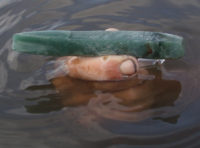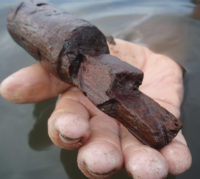 Archaeologists have unearthed a jadeite tool with a rosewood handle at a Maya salt works site in Belize. This is the first time the wooden handle of one of these tools has been found intact, preserved by the waterlogged mangrove peat at the Ek Way Nal site in southern Belize. It dates to the Maya Classic Period (300–900 A.D.) when the Paynes Creek Salt Works, a network of 110 ancient salt works operated in a mere three square mile area.
Archaeologists have unearthed a jadeite tool with a rosewood handle at a Maya salt works site in Belize. This is the first time the wooden handle of one of these tools has been found intact, preserved by the waterlogged mangrove peat at the Ek Way Nal site in southern Belize. It dates to the Maya Classic Period (300–900 A.D.) when the Paynes Creek Salt Works, a network of 110 ancient salt works operated in a mere three square mile area.
The jadeite of the gouger and the wood of the handle are very high-quality materials. The stone is translucent green, the most prized color of jadeite which ranges from translucent to opaque. The jadeite’s translucency is caused by the tight microstructure of its grains, which makes it much harder and more durable than the opaque versions of the stone. Its beauty and the high degree of difficulty in working it made translucent jadeite the preferred greenstone of Maya royalty. It is usually found in the tombs of the highest rank, like King Pacal’s tomb at Palenque, and at ceremonial sites where it was used in religious rituals and as diplomatic gifts. Grave goods of jewelry, carved plaques and statuary were important indicators of elite status.
 The hardness of the translucent jadeite that made it so desirable for royal adornment also made it desirable as a tool. The handle is Honduras rosewood, a dense, finely grained wood that even today is considered difficult to carve, so it too was a strong, sturdy material ideal for a tool.
The hardness of the translucent jadeite that made it so desirable for royal adornment also made it desirable as a tool. The handle is Honduras rosewood, a dense, finely grained wood that even today is considered difficult to carve, so it too was a strong, sturdy material ideal for a tool.
An analysis of the stone found that it is 98% jadeite by volume and that its quality and translucent blue-green shade approaches gem grade. That such expensive materials were used to make a utilitarian object like a gouger attests to the importance of salt in the Classic Maya economy, and the deep pockets of the salt workers themselves. They weren’t “working in the salt mines” in the modern sense of the idiom.
“The salt workers were successful entrepreneurs who were able to obtain high-quality tools for their craft through the production and distribution of a basic biological necessity: salt. Salt was in demand for the Maya diet. We have discovered that it was also a storable form of wealth and an important preservative for fish and meat,” said lead researcher and anthropologist Heather McKillop, who is the Thomas & Lillian Landrum Alumni Professor in the LSU Department of Geography & Anthropology.
The tool would not have been used to gouge hard materials like stone or wood. It was found in a salt kitchen, so researchers believe it was probably used in jobs like scraping salt, gutting calabash gourds, or cleaning fish or meat before salting.
I wonder how the handle was fitted?
Quite interesting :thanks:
“Greenstones” aka amphibolites which include jadeite and nephrite jade make good tools because their crystal structure is fibrous. This makes them very tough to impact and stress. Quartz, for example, will give a sharper edge but is very brittle. Brittle stones like quartz or chert (flint) are worked by knapping while tough amphibolites are shaped by grinding.
Regarding how the handle was fitted, I imagine that it was lashed on along the first “step “ (right end in the pic) and butted up against the middle step to counteract the pushing force.
But why has nobody mentioned the disembodied drowned hand presenting these treasures? The text says they were unearthed
I’ve been to two Maya salt trading centers, Cerros across the Bay from Corozal Belize and Xcambo on Yucatan’s north coast. Xcambo is well worth the effort of visiting. It is set back in an estuary, protected from the main force of the ocean, the salt pans are still being used. The dock is still evident, fresh water springs abound, there is a small ruin, but the dock area is what is unique. There is a ten acre plaza next to the dock, that’s room for a lot of trading. Cerros is interesting but the sea has had its way with the site. I would not skip it if you are in the area, but Xcambo is worth a special trip.
Andersson, that ‘disembodied drowned hand’ doesn’t look overly salty –obviously, the brine is not strong enough:
The ‘Hallstatt culture’, for example, is named for its type site, Hallstatt, a lakeside village in the Austrian Salzkammergut southeast of Salzburg, where there was a rich salt mine (cf. ‘Hallein Salt Mine’). Moreover, ‘Hallstatt’ (ἁλάτιον- τόπος, “Halatopolis”) virtually means ‘salt place’, and some 1,300 burials are known, many with fine artifacts.
In 1734 AD, however, a pickled miner from around 350BC was found, still trapped deep down in the mine. Salt mining in the current Hallstatt mine itself had kicked off around 1500BC, but Hallstatt salt has been dealt with for 7000 years (w/ antler, stone axes, ..and.. water!).
Pickled meats were actually a Celtic trading commodity. In Hallstatt also water was used (and I think still is) on a massive scale, maybe similar to how Cato (maior) was putting it around 150BC:
—————-
On Farming or On Agriculture (De Re Rustica), ch.74‑90, by Cato the Elder, written ~150BC:
—
Salem candidum sic facito. Amphoram defracto collo puram inpleto aquae purae, in sole ponito. Ibi fiscellam cum sale populari suspendito et quassato suppletoque identidem. Id aliquotiens in die cotidie facito, usque adeo donec sal desiverit tabescere biduum. Id signi erit: menam aridam vel ovum demittito; si natabit, ea muries erit, vel carnem vel caseos vel salsamenta quo condas. Eam muriam in labella vel in patinas in sole ponito. Usque adeo in sole habeto, donec concreverit. Inde flos salis fiet. Ubi nubilabitur et noctu sub tecto ponito; cotidie, cum sol erit, in sole ponito.
—
Recipe for clearing salt: Break off the neck of a clean amphora, fill with clear water, and place in the sun. Suspend in it a basket filled with common salt and shake and renew from time to time. Do this daily several times a day until the salt ceases to dissolve for two days. You can find when it is saturated by this test: place a small dried fish or an egg in it, and if it floats you have a brine strong enough to pickle meat or cheese or salted fish. Place this brine in flat vessels or in pans and expose it to sun. Keep it in the sun until it solidifies, and you will have a pure salt. In cloudy weather or at night put it under cover, but expose it to the sun every day when there is sunshine.
—————-
:hattip:
the article is educative